 Rebuilding lives: McKellar Centre trauma team members Jess Johnston, Dana Sullivan, Debbie Verikios, Linda Hirst and Angharad Williams.
Rebuilding lives: McKellar Centre trauma team members Jess Johnston, Dana Sullivan, Debbie Verikios, Linda Hirst and Angharad Williams.
By John Van Klaveren
DESPITE common perceptions, the trauma rehabilitation unit at North Geelong’s McKellar Centre can be a happy place.
“The stories might be sad but we focus on positive outcomes,” Jess Johnston said.
Jess and trauma team co-workers Dana Sullivan, Debbie Verikios, Linda Hirst and Angharad Williams make up an inter-disciplinary team dealing with road trauma victims, among others.
“We draw support from other members of the team,” Jess explained.
Many of the clients who have shared their stories with the Independent for its Shattered Lives series have come to know the team members well.
“We see the role as moving forward, we get to see the positives. People do make recoveries,” Dana said.
“Often we get people after they’ve grieved and are ready to move on.”
The team, all rehabilitation specialists in their own fields, has long experience in working with road trauma clients.
“People are learning to readjust and realign their life goals,” Debbie explained.
“People usually go through a worst-case scenario before understanding their own goals.
“It takes some longer, depending on their level of insight and awareness.”
Jess said road trauma clients often reached a point of re-evaluation when faced with the task of rehabilitation.
“Many of our clients come to life with a different perspective and priorities afterward,” she said.
The team shared a quiet laugh when asked whether dealing with road trauma victims day in and day out gave them pause for reflection.
“Life can change in an instant, we do sometimes reflect on that,” Linda admitted, “but most of the time we’re too busy.”
Dana said the team worked with families as much as clients, its efforts extending into their work, school and social lives.
“Family relationships can change as a result and need adjustment,” she observed.
“Sometimes there’ll be multiple injuries from the same family or one family member is killed and others survive.
“Guilt is often present, a natural response.”
When it came to prevention, the team unanimously agreed that the client had the greatest impact on those around them.
“It’s the people and their own connections that has the greatest impact on family, friends, school mates or workmates,” Angharad said.
“When people see it close to home, it rings true.”






